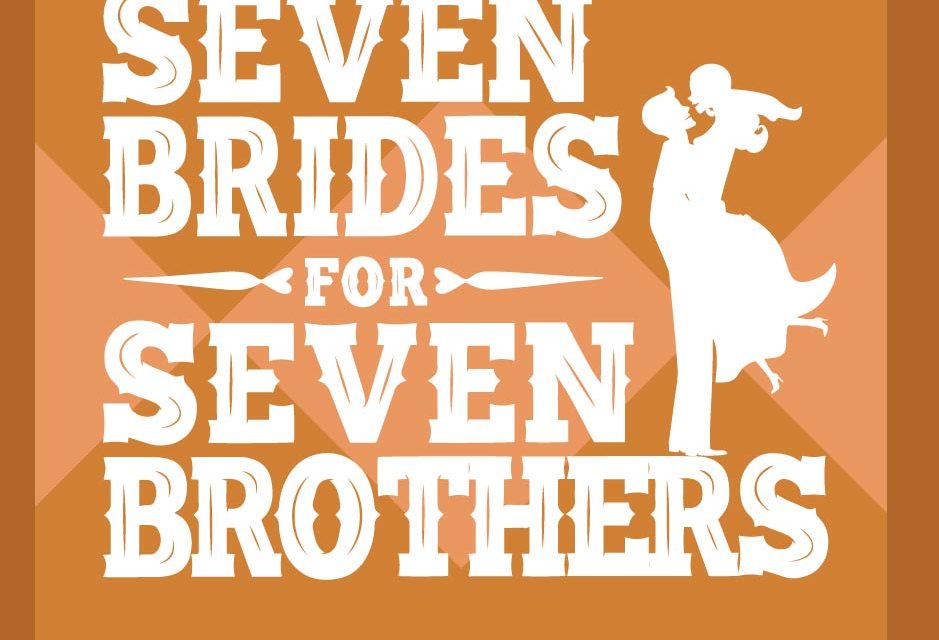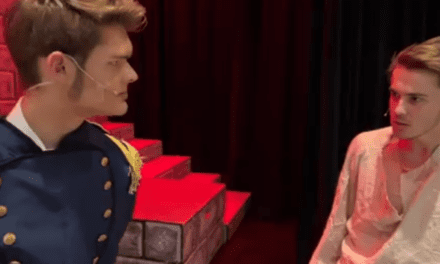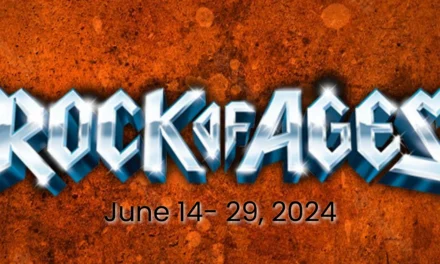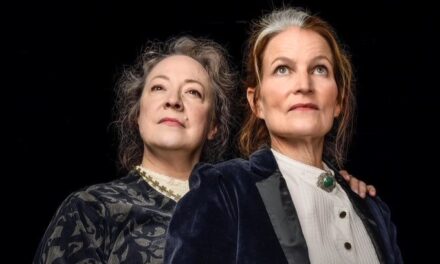WASHINGTON TERRACE — Seven Brides for Seven Brothers is a classic that is dear to my heart, as it was one of the first musicals I was introduced to as a child. So, I was excited to take my daughter to see opening night at Beverly’s Terrace Plaza Playhouse and pass on the love I have for this musical. Director Susan Wilhelm has made a show full of joy and fun for all theatre-goers with good singing and dancing.

Show closes April 9, 2022.
The musical Seven Brides for Seven Brothers is adapted (with a script by Lawrence Kasha and David Landay and based on a story by Stephen Vincent Benet, music by Gene de Paul, lyrics by Johnny Mercer, and additional songs by Al Kasha and Joel Hirschhorn) from the film of the same name and tells the story of Adam Pontipee, a mountain man in 1850s Oregon. He sets off for the local town to find a bride and spots Milly Bradon, a newly orphaned waitress in town, and decides she is the gal for him. Adam quickly sweet talks her into marrying him. She is excited to leave the town and take care of only one man, but is shocked when she gets to Adam’s farm and learns that he lives with six brothers, which she is now expected to cook and clean for as well. Milly comes to love her new brothers-in-law and teaches them the proper way to court and be gentlemen so they can catch they eye of a town girl for themselves. Adam also wants to help them catch a town girl, but has much different tactics, which creates the conflict of the show.
Adam was played by Brian Sears, who has a nice tenor voice as he opens the show with “Bless Your Beautiful Hide,” one of the well-known numbers from the score. Some of the low notes that require a baritone were a little weak, but still on pitch. Sears’s voice blends well with Milly and the brothers. Adam’s solo “Where Were You?” was more in his register, and Sears gave a powerful performance that really showed what made Adam into the rough-around-the-edges head of the family.

Victoria Hall as Milly Bradon and Brian Sears as Adam Pontipee.
The spunky Milly was performed nicely by Victoria Hall, who handled her numbers with pleasing vocals, especially on “I Married Seven Brothers” and the sweet lullaby number “Glad That You Were Born.” While it is nice to hear Hall and Sears sing together, they lacked chemistry. Susan Wilhelm does not have any kissing in the show, perhaps to reduce the risk of spreading COVID, or just to make the show extra family-friendly. Having no kissing between the couples makes it a little harder to show a romantic bond, but the couples do all have a nice warmth. I particularly liked the trio of “Love Never Goes Away” that Adam and Milly perform with Gideon (played by Peter Jenkins).
While both the leads were strong, the best part about this production of Seven Brides for Seven Brothers is the fun chorus. The Brothers Pontipee were superb from A-G and bring lots of personality and pluck to their group numbers “Goin’Courting” and “Sobbin’ Women.” Music director Jamie Balaich should be pleased at how well their voices harmonize. The ladies of the cast could all sing as well and sounded lovely with their parts on “We’ve Got To Make It Through the Winter.”
As far as plot goes, the show doesn’t have anything profound to offer. A bunch of mountain men sneak into town to steal girls they have a crush on and take them to their secluded cabin in hopes that the women will develop Stockholm syndrome. Plot isn’t the appeal of the show so much as the dancing, and choreographer Ginny Spencer Waldron delivers in this production. The original 1954 film was choreographed by Michael Kidd and has been called some of the most rousing choreography ever filmed. Many productions give some homage to Kidd’s influence, which I noticed in Waldron’s interpretation as well and found it very successful. Waldron uses several styles of movement like square dance, ballet, and Broadway. The big group numbers were very polished and used all her dancers well. The group work was clean and simple enough for all cast members to execute it. Then the smaller groups have fun and exciting lifts and really show off her more advanced dancers. The girls have some very nice ballet interludes that were lovely. I enjoyed immensely the challenge dance during the town social. I am unsure if Waldron also choreographed all the fight scenes, as they were more of a mixed bag, but the dancing was fun and exciting throughout the show.
The set design by Brent Taft was simple and effective, as the bulk of the stage usually needed to be clear for the large dance numbers. The Pontipee house and barn were created with wagons that moved in and out quickly to keep the pace of the show going. The backdrop of the Oregon country was beautiful, with the lighting design by Don Wilhelm that showed day, sunset, and the night sky over the tree line. On the other hand, there were quite a few times that I wish the actor’s mics had been turned up louder. It was never to the point I could not hear the actors, but they needed to be turned up more to fill the space.
The costume designs by Jim Tatton and Stephanie Petersen were full of rich colors and bold patterns. Instead of color-coordinating romantic couples (a frequent costuming trope in musicals with many romantic couples), the costumers chose a more realistic costume setting. I wanted the color coordination at first, but I didn’t mind the more realistic costuming by the end of the show. Some of Susan Wilhelm’s direction even played with the idea of keeping straight which gal goes with which brother, and it made created some fun stage business. Milly’s costumes are particularly well done, as they go from a darker town dress and end the show in a very bright spring floral number showing that she found her happiness with her new family.
Beverly’s Terrace Plaza Playhouse’s version of Seven Brides for Seven Brothers is a classic for a simple reason: it is full of fun songs and flashy dance scenes that are enjoyable to all ages for a great escape to the theatre. I am glad I could pass on this tradition to my daughter, whom I will talk to about the proper way of “goin’ courting” when she’s older. But for now, we can enjoy this fun show together.





